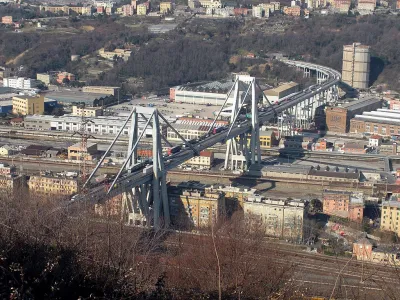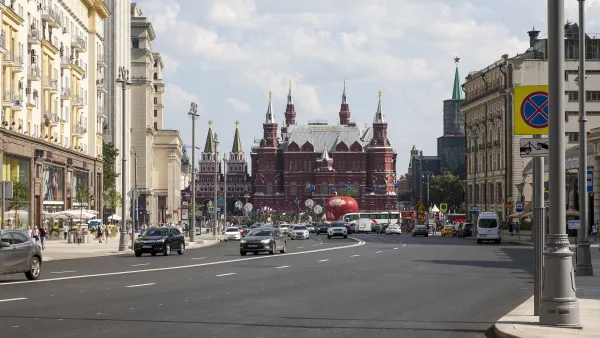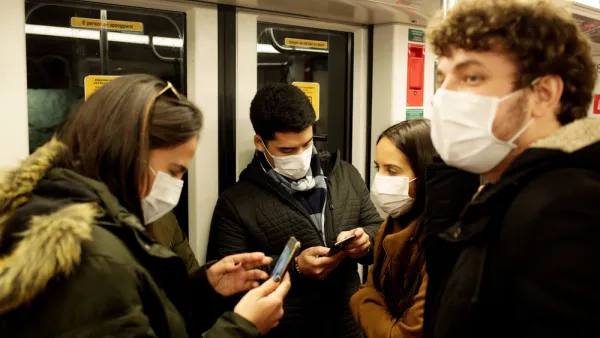At least 39 people died when the Ponte Morandi bridge collapsed in Genoa, Italy during a storm on Tuesday. The cable-stayed bridge is part of a viaduct on the A10 toll road that goes to France, operated and maintained by Autostrada per l'Italia.

"A vast span of the Morandi bridge caved in during a heavy rainstorm in the northern port city [of Genoa], sending about 35 cars and several trucks plunging 45 metres (150ft) on to railway tracks below," according to The Guardian.
"Italian political leaders have been quick to point the finger at [Autostrade per l’Italia,] the private company responsible for maintaining the Ponte Morandi Bridge," which opened in 1967 with the Autostrada A10, reports Amy Held for NPR. The cable-stayed bridge is named after designer Riccardo Morandi.
Deputy Prime Minister Matteo Salvini said he would work to "identify the culprits of this disaster, which will not go unpunished." He tweeted that those responsible will "pay dearly."
The company, a "leading European Concessionaire for toll motorway construction and management," according to owner Atlantia Group, defended its record of maintaining the 51-year-old bridge.
From 2012 to 2017, "the company's investments in safety, maintenance and upgrading of the network have exceeded 1 billion euros [$1.134 billion] a year," Autostrade said in a statement emailed to NPR. The company added that its safety investments have resulted in fewer deaths and accidents.
Officials say it's too early to explain why the bridge collapsed during the powerful storm. The New York Times account of the incident helps to put the government's response into context.
"The calamity presented a serious test of Italy’s new government, a coalition of populist parties that was formed only months ago, report Gaia Pianigiani, Elisabetta Povoledo and Richard Pérez-Peña on Aug. 14. "They rode to power on a wave of anti-establishment anger, but the coalition is led by people who had little to no experience governing, and now must demonstrate that they can manage a crisis and the scrutiny that comes with it."
"The Morandi bridge has been riddled with structural problems since its construction in 1967, which has led to expensive maintenance and repeated criticism from engineering experts," report The Guardian's Angela Giuffrida and Lorenzo Tondo.
On Tuesday the specialist engineering website Ingegneri.info published a piece that highlighted longstanding concerns over the bridge, calling it “a tragedy waiting to happen”.
"Restructuring work on the bridge was carried out in 2016," reported Giuffrida on Tuesday. "The highway operator said work to strengthen the road foundations of the bridge was being carried out at the time of the collapse, and the bridge was constantly monitored."
Sylvia Poggioli, senior European correspondent for NPR's international desk, also reports on the calamity (audio and transcript). In a separate, 5-minute (audio-only) interview on Wednesday with Here & Now's Robin Young, Poggioli explains that the bridge had exceeded its traffic capacity, the definition making it functionally obsolete but not necessarily structurally deficient.
"Italians pride themselves on repairing and restoring ancient things, and the idea of tearing something down....is not in their mentality," states Poggioli, adding, "this may require some revision."
John Surico also explores reasons for the bridge collapse in an insightful piece for CityLab. "The incident has sparked an urgent debate over the country’s ability to maintain its postwar infrastructure."
FULL STORY: Death Toll In Genoa Bridge Collapse Rises To 39

Analysis: Cybertruck Fatality Rate Far Exceeds That of Ford Pinto
The Tesla Cybertruck was recalled seven times last year.

National Parks Layoffs Will Cause Communities to Lose Billions
Thousands of essential park workers were laid off this week, just before the busy spring break season.

Retro-silient?: America’s First “Eco-burb,” The Woodlands Turns 50
A master-planned community north of Houston offers lessons on green infrastructure and resilient design, but falls short of its founder’s lofty affordability and walkability goals.

Test News Post 1
This is a summary

Analysis: Cybertruck Fatality Rate Far Exceeds That of Ford Pinto
The Tesla Cybertruck was recalled seven times last year.

Test News Headline 46
Test for the image on the front page.
Urban Design for Planners 1: Software Tools
This six-course series explores essential urban design concepts using open source software and equips planners with the tools they need to participate fully in the urban design process.
Planning for Universal Design
Learn the tools for implementing Universal Design in planning regulations.
EMC Planning Group, Inc.
Planetizen
Planetizen
Mpact (formerly Rail~Volution)
Great Falls Development Authority, Inc.
HUDs Office of Policy Development and Research
NYU Wagner Graduate School of Public Service




























